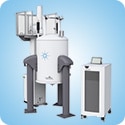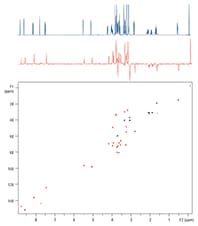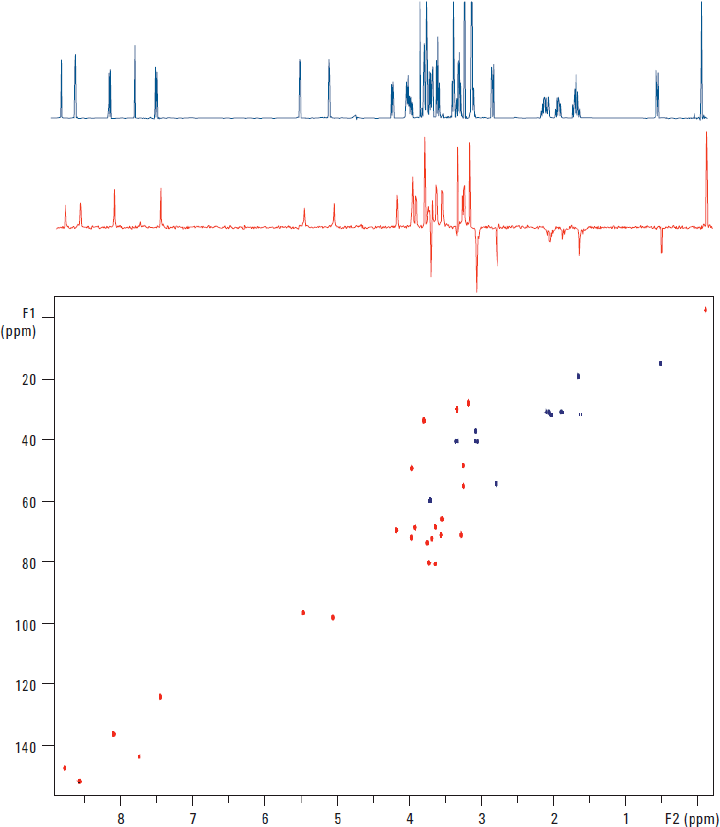Access Agilent eNewsletter, July 2014
>> Update My Profile | Subscribe to Access Agilent | Article Directory

Real-time homonuclear decoupling for increased spectral dispersion and lower detection limits in heterocorrelation experiments
By Péter Sándor
Agilent Applications, NMR Applications Scientist
Real-time pure shift CRISIS-HSQC (Heteronuclear Single Quantum Coherence) experiments take detection limits or measurement time to the next level, delivering rapid and reliable assignment of crowded spectra. This heteronuclear correlation method simplifies homonuclear multiplet structures in the observed dimension with enhanced 2D cross-peak amplitudes, providing significantly lower detection limits and substantially shortened measurement times.
 Enlarge
Enlarge
Figure 1. Sequence scheme of the real-time pure shift CRISIS-gHSQCAD experiment. White and gray bars represent 90 and 180 degree pulses respectively. Broadband 13C decoupling is applied during status C.
 Enlarge
Enlarge
Figure 2. 13C-1H real-time pure shift multiplicity edited gHSQCAD correlation map of the four-component mixture.
 Enlarge
Enlarge
Figure 3. Sugar region of the gHSQCAD (left) and real-time pure shift gHSQCAD (right) spectra of the four-component mixture. Encircled cross-peaks originating from a non-equivalent methylene pair show residual 2JHH splitting. At the top, the F1 trace of the corresponding 2D spectra at 68.8 ppm show the simplified multiplet structure and enhanced signal amplitudes.
Taking NMR detection limits and reduced measurement times to the next level
HSQC is the most widely-used NMR method for correlating the chemical shifts of directly-bound 13C-1H and 15N-1H pairs. Spectral resolution in the indirect dimension is limited only by the requested digital resolution or the X nucleus’ relaxation properties. In the observed dimension, practical limits are posed by the multiplet widths determined by homonuclear scalar interactions.
A recent publication by Paudel et al. [1] dramatically simplifies the F2 multiplets. A windowed acquisition block consisting of trains of bilinear rotation decoupling (BIRD) [2] refocusing elements collects chunks of data with refocused JHH modulation and suppresses JXH with broadband heteronuclear decoupling. The resulting “pure shift” spectrum far exceeds foreseeable static magnetic field gains for decades to come and takes detection limits and reduced measurement times to the next level. The power of this technique for reliable assignment of crowded spectra was recently demonstrated on the Agilent ProPulse NMR System.
Figure 1 shows the acquisition scheme combined with the CRISIS-gHSQCAD pulse sequence [3]. Coherence pathway selection was achieved by pulsed field gradients. The chunks in the acquisition loop were 25.6 m/sec long with an overall acquisition time of 256 m/sec.
A D2O sample solution of a four-component mixture (amikacin disulphate, 3-(trimethylsilyl)-1-propanesulphonic acid sodium salt (TSPS), caffeine, and nicotinamide) was used that covers the typical chemical shift range for both protons and protonated 13C atoms, demonstrating the efficiency of the broadband inversion pulses in the BIRD-acquisition segment.
In Figure 2 we show the complete multiplicity-edited real-time pure shift 2D HSQC map. The top section captures the high resolution proton spectrum (blue) and the first-increment 1D pure shift HSQCAD spectrum (red). This latter spectrum reveals the same simplified proton multiplet structure as the 2D spectrum.
We then compared the sugar region of the conventional and pure shift HSQC spectra run under identical conditions (Figure 3). The top three cross-peaks in the 26-33 ppm region with identical appearance in both spectra are the methyl singlets of caffeine. All other CH cross-peaks (in red) collapse into singlets in the pure shift spectrum. Magnetically equivalent CH2 pairs follow identical response (blue singlets on the right) while the nonequivalent methylene protons attached to the same 13C partner, retain the germinal coupling, shown as doublets (encircled in the 2D map). The F1-trace at 68.6 ppm from the respective 2D spectra at the top illustrates the pure shift method advantage: collapse of the proton multiplets into singlets (except for nonequivalent CH2 signals that collapse to doublets), and the accompanying signal amplitude gain. The ultimate sensitivity gain is a function of the number of scalar coupling partners of a given nucleus. Singlets do not profit from broadband homonuclear decoupling, but signals with numerous coupling partners, and hence complex multiplet structure, do. Peak heights increase by an average factor of 1.7 for doublets and may reach a factor of three for complex multiplets. For multiplets, the ultimate detection limit could be lowered by a factor of 3 or the experiment time may be reduced by almost a factor of 10.
Agilent ProPulse delivers increased spectral dispersion and lower detection limits
We can see from the example described in this article, which utilized the Agilent ProPulse system, that real-time pure shift CRISIS-HSQC experiments offer lower detection limits and measurement time, delivering rapid and reliable assignment of crowded spectra.
The Agilent ProPulse NMR System brings the power of NMR to researchers of all types and skill levels. ProPulse delivers the highest quality data and unrivaled simplicity for highly-productive experimental setup, optimization, and data collection.
Agilent is committed to improving the entire NMR user experience. Discover the complete line of Agilent NMR solutions for analyzing both small- and large-molecule compounds in research and industrial applications.
References
- Paudel, L., et al., Angew. Chem. Int. Ed., 2013, 52, 11616–11619. (Supported by a UR grant from the Agilent Technologies Foundation.)
- Garbow, J.R., Weitecamp, D.P., Pines, A. Chem. Phys. Lett., 1982, 93, 504-509
- Boyer, R.D., Johnson, R., and Krishnamurthy, K. JMR, 2003 (165) 53-259
>> Update My Profile | Subscribe to Access Agilent | Article Directory
Figure 1.

Sequence scheme of the real-time pure shift CRISIS-gHSQCAD experiment. White and gray bars represent 90 and 180 degree pulses respectively. Broadband 13C decoupling is applied during status C.
Figure 2.

13C-1H real-time pure shift multiplicity edited gHSQCAD correlation map of the four-component mixture.
Figure 3.

Sugar region of the gHSQCAD (left) and real-time pure shift gHSQCAD (right) spectra of the four-component mixture. Encircled cross-peaks originating from a non-equivalent methylene pair show residual 2JHH splitting. At the top, the F1 trace of the corresponding 2D spectra at 68.8 ppm show the simplified multiplet structure and enhanced signal amplitudes.